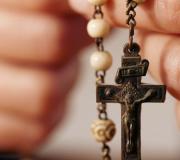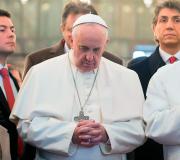Who wrote Cheburashka the author of the fairy tale. Cheburashka's birthday: how Uspensky found the unusual name of his favorite character
It must be said that this simple question (or rather, the answer to it) is not as straightforward as it seems at first glance. The funny hero of literary works and cartoons, who is also the official symbol of the Russian team at the Olympic Games, at one time became the stumbling block of several legal disputes. We will try to talk about why this happened and who actually invented Cheburashka in our article.
Literary character
On the one hand, this is a bookish image. And the writer Eduard Uspensky came up with it. Yellow eyes (like an eagle owl). Round big head (like a hare). The tail is fluffy and short (like a little bear cub). By the way, in the first issues of the book about Cheburashka and Crocodile Gena, published even before the appearance of the famous cartoon in 1966, the animal looked different. This is how two other artists Alfeevsky and Kalinovsky saw his image. In short, we can say: it’s not similar at all!
Cartoon hero
The bright and unforgettable image of Cheburashka from the Soviet cartoon, published in 1969, was created by animator Leonid Shvartsman (real name Israel Aronovich Shvartsman). And after that, in all the other cartoons about Cheburashka, it was this brilliant Soviet artist who created the characters. So the right to the cartoon animal belongs to him.
Origin of the name
According to Uspensky’s fairy tale, an unknown animal, when transported along with oranges, tried to “cheburah”, that is, to fall, simply put. Hence the name - Cheburashka. In Dahl's dictionary, the concept of “cheburahnutsya” is described as: “to crash”, “to stretch out”, “to fall”. And the word “Cheburashka” means: a doll like a Vanya-Vstanka, which, no matter how you throw it, gets on its feet.
Brand division
The trials between Uspensky and Shvartsman began after the collapse of the USSR, in the nineties. The peak occurred in 2004-2007. The artist drew attention to the fact that the image of Cheburashka in the first editions of the books was significantly different from the cartoon character drawn later. And the difference is definitely there. Therefore, it is still reasonable to talk about two different author’s characters: a cartoon hero and a literary hero.
Soviet cinema gave the world unusual heroes. While famous directors were working on films for adult audiences, animators were thinking about how to surprise little Octobrists and pioneers. Cartoon creators used plots from books and created authentic stories, which were later embodied on the screen. , the Wolf and the Hare from “Well, wait a minute!”, It would take a long time to list the characters beloved by children. The first mythical hero of Soviet animation was Cheburashka - an unknown creature of unknown origin.
History of creation
Cheburashka is the name of a character in a book written by a children's author. Based on the work “Gena the Crocodile and His Friends,” the director made a film in 1969. The hero of the book gained fame after the film was released.
Cheburashka is an unusual creature. It has two huge round ears, its body is covered with brown fur, and it is not clear whether this animal is male or female. His appearance was thanks to the production designer, Leonid Shvartsman. After the cartoon was translated for showing in other countries, children in all corners of the planet recognized Cheburashka. In English his name was Topl, in German - Kullerchen or Plumps, Drutten in Swedish and Muksis in Finnish. At the same time, the children did not know who the creator of the character was.
Despite the legend about the appearance of Cheburashka published in the preface, Eduard Uspensky assured readers that it was not a child’s toy at all. In an interview with a Nizhny Novgorod newspaper, the writer admitted that he once watched a friend’s little daughter. The girl constantly fell, dressed in someone else's long fur coat.

Her father, noticing these actions, commented on what was happening with the word “cheburahnaya.” A curious word was etched in Uspensky’s memory. Later, the author learned that in the dictionary “Cheburashka” is a synonym for “vanka-vstanka”, also known as tumbler. Cheburashkas were small wooden floats made by fishermen to lure their catch.
Biography and plot
Based on the preface of Uspensky’s book, it becomes clear: in childhood, the author had a defective toy with a similar name. She looked like a strange animal with round eyes, large ears, a small body and a short tail. The parents assured the boy that Cheburashka lived in the tropical jungle. The animal feeds on oranges, and one day, after climbing into a fruit box to eat it, the baby fell asleep in it. The box was sealed and taken to a big city grocery store.

Cheburashka's name appeared the moment he was discovered by the store director. The well-fed animal constantly fell - it cheburahed, according to those around it. Due to the fact that he could not sit still without falling, he was given a funny nickname. The character of the hero is soft. The baby is sweet and friendly, naive, friendly and curious. The diminutive name describes his nature. The sometimes awkward but charming hero evokes the affection of the audience and the characters in the cartoon.

According to the plot, they are trying to place a strange animal in a zoological garden to live with other animals from the tropics. But the zoo didn’t know which animals to let the unknown creature into. He was passed from hand to hand until Cheburashka ended up in a thrift store. This is where I found him. He worked at a zoo and was lonely. While looking for friends, Gena was posting advertisements and came across Cheburashka. Now the animal duo is looking for company. It will include the lion Chandra, the puppy Tobik and the girl Galya. The negative character of the work is the owner of the pet rat Larisa.
Between 1966 and 2008, Eduard Uspensky, in collaboration with production designers, created eight plays about the adventures of Cheburashka and friends. In the 1970s, several children's television and radio programs were broadcast in Sweden. Audio records with fairy tales about Cheburashka and Gena and children's magazines were popular. The characters went abroad along with dolls that a tourist brought from a trip to the Soviet Union. Cheburashka was christened Drutten. In Swedish, this word is translated as “stumble”, “fall”, which was characteristic of the hero.

An interesting nuance: on Soviet television, cartoon characters were dolls, and on Swedish television they were puppets. The characters sang and talked about life, but the dialogue was very different from the authentic ones. Even Cheburashka's song sounded completely different. Today Drutten is a full-fledged character in Swedish animation. Modern children do not know the history of its origin.
In 2001, the Japanese discovered the cartoon character, and in 2003 they bought the rights to distribute this image from Soyuzmultfilm for 20 years. The animated cartoon “Cheburashka Arere” has been broadcast in Tokyo since 2009. In 2010, the character was accompanied by friends from Uspensky’s book. Puppet cartoons on the theme of the hero's adventures began to be shown on TV. Today in Japan the cartoons “Crocodile Gena”, “Shapoklyak Advice”, “Cheburashka and the Circus” are broadcast.
Quotes
Works of Soviet cinema and animation are famous for their quotes that audiences love. Heartfelt humorous remarks sink into the soul and are passed on from mouth to mouth for many years. Phrases from the book, transferred to the cartoon, create a special atmosphere, involving the young audience in the plot.
“A young crocodile of about fifty wants to make friends.”
This quote raises questions: is the age of a crocodile comparable to human years? Can crocodiles want to be friends? Why is the image of a crocodile associated with an adult? Cheburashka asks Gene a reasonable question about age, and little viewers learn that crocodiles can live up to three hundred years.

A series of cartoons about the adventures of Cheburashka has a moralistic background. Recommendations and advice to children are presented with the help of the main characters. Kindness is the main value for the characters. At the same time, old woman Shapoklyak assures:
“Whoever helps people is just wasting their time. You cannot become famous for good deeds.”
The old woman’s wrongness is clear at first glance, and the kids understand that it is worth helping each other. Good deeds are certainly connected with the main goal of all children of the Soviet Union - enrollment as pioneers. Gena and Cheburashka are no exception:
“You have to do a lot of good things to get into the Pioneers,” says Gena, motivating Cheburashka, and at the same time the audience on the other side of the screen.
Despite the characteristic features of Soviet animation, children's films about Cheburashka are of interest to modern children. They keep curious kids and nostalgic adults glued to their screens.
The image of Cheburashka known today was created by cartoonist Leonid Shvartsman.
Origin
According to the preface to the book “Crocodile Gena and His Friends,” Cheburashka was the name given to a defective toy that the author had in childhood, depicting a strange animal: either a bear cub or a hare with big ears. His eyes were large and yellow, like those of an eagle owl, his head was round, hare-shaped, and his tail was short and fluffy, such as is usually the case with small bear cubs. The boy's parents claimed that this was an animal unknown to science that lives in hot tropical forests. Therefore, in the main text, the heroes of which are allegedly the children's toys of Eduard Uspensky, Cheburashka is really an unknown tropical animal that climbed into a box of oranges, fell asleep there and, as a result, ended up with the box in a big city. The director of the store where the box was opened called it “Cheburashka”, since the animal, which had gorged itself on oranges, was constantly falling (cheburashka):
He sat and sat and looked around, and then suddenly fell off the table and onto the chair. But he couldn’t sit on the chair for long - he fell over again. On the floor.
- Wow, what a Cheburashka! - the store director said about him, - He can’t sit still at all!
This is how our little animal found out that its name is Cheburashka...
Stories and plays about Cheburashka were written by Eduard Uspensky (plays together with Roman Kachanov):
“Crocodile Gena and his friends” (1966) - story
“Cheburashka and his friends” (1970) - play (together with R. Kachanov)
“Gena the Crocodile’s Vacation” (1974) - play (together with R. Kachanov)
“The Business of Gena the Crocodile” (1992) - story (together with I. E. Agron)
"Gena the Crocodile - Police Lieutenant"
"Cheburashka goes to the people"
"The abduction of Cheburashka"
Based on the book, director Roman Kachanov created four cartoons:
"Crocodile Gena" (1969)
"Cheburashka" (1971)
"Shapoklyak" (1974)
“Cheburashka goes to school” (1983)
After the release of the first series of cartoons, Cheburashka became very popular in the USSR. Since then, Cheburashka has been the hero of many Russian jokes. In 2001, Cheburashka gained great popularity in Japan.
At the 2004 Summer Olympics in Athens he was chosen as the mascot of the Russian Olympic team. At the 2006 Winter Olympics, the symbol of the Russian Team, Cheburashka, changed into white winter fur. At the 2008 Summer Olympics in Beijing, Cheburashka was “dressed” in red fur.
At the 2010 Winter Olympics, the Cheburashka mascot became the owner of blue fur.
In the 1990s and 2000s, disputes erupted around the copyright of the image of Cheburashka. They concerned the use of the image of Cheburashka in various products, the names of kindergartens, children's variety studios and clubs (which was a common practice in Soviet times), as well as the authorship of the image of Cheburashka itself, which, according to Eduard Uspensky, belongs entirely to him, while his opponents claim that the characteristic image of Cheburashka with big ears known today was created by Leonid Shvartsman. In the 1990s, Eduard Uspensky also acquired the rights to the Cheburashka trademark, which had previously been used in products such as candy and children's cosmetics. The use of the name became the subject of a dispute between the writer and the Red October confectionery factory. In particular, in February 2008, the Federal State Unitary Enterprise Film Fund of the Soyuzmultfilm Film Studio (the owner of the rights to the image) expressed its intention to seek compensation from the creators of the film “The Best Film” for using the image of Cheburashka without permission.
Origin of the word "Cheburashka"
Uspensky rejects the version about the defective toy, set out in the introduction to his book, as written specifically for children. In an interview with a Nizhny Novgorod newspaper, Eduard Uspensky says:
I came to visit a friend, and his little daughter was trying on a fluffy fur coat that was dragging along the floor,<…>The girl constantly fell, tripping over her fur coat. And her father, after another fall, exclaimed: “Oh, I screwed up again!” This word stuck in my memory and I asked what it meant. It turned out that “cheburahnutsya” means “to fall.” This is how the name of my hero appeared.
In the “Explanatory Dictionary of the Living Great Russian Language” by V. I. Dal, both the word “cheburakhnutsya” is described in the meaning of “fall”, “crash”, “stretch out”, and the word “Cheburashka”, which he defines in various dialects as “a saber of a burlatsky strap” , hanging on its tail,” or as “a stand-up roly-poly, a doll that, no matter how you throw it, gets to its feet on its own.” According to Vasmer's etymological dictionary, “cheburakhnut” is derived from the words chuburok, chapurok, cheburakh - “a wooden ball at the end of a burlatsk tow”, of Turkic origin. Another related word is “chebyrka” - a whip with a ball on the end of the hair.
The origin of the word “Cheburashka”, in the sense of a tumbler toy, described by Dahl, is due to the fact that many fishermen made such toys from wooden balls, which were floats for fishing nets, and were also called Cheburashka.
As Eduard Uspensky said, the image of Cheburashka was born thanks to a painting he once saw: “I was visiting my friend and saw a little girl dressed in a thick fur coat with a large collar. The fur coat was too big for the girl, and she constantly fell - she would take a step and fall. My friend said: “Oh, I’m crazy!” That’s the first time I heard this word.”According to Vladimir Dahl's Explanatory Dictionary, the word "Cheburashka" meant "a doll, a little roly-poly who stood up on his own no matter how hard you threw him." The verbs “cheburakhat” and “cheburakhnut” were used in the meaning of “throw, throw, overturn with thunder, bang, slap.”
Thanks to the efforts of the artist Leonid Aronovich Shvartsman, Cheburashka became one of the most beloved cartoon characters of the USSR. “In the process of making the film, the tail fell off. The cartoon Cheburashka has eyes like a human child. He has big ears, a frame around his face. And, of course, a charm has come that is not found in the drawings of other artists,” notes Shvartsman.
The word “Cheburashka” has existed for quite a long time, and, contrary to popular belief, it was not invented by the writer Eduard Uspensky. In the "Explanatory Dictionary of the Living Great Russian Language", compiled by V.I. Dahlem, it is reported that “Cheburashka is an old toy, a doll, a roly-poly, which no matter how you throw it, will still get back on its feet.”
Another scientist is lexicographer S.I. Ozhegov in his “Dictionary of the Russian Language” cites two words used in common parlance - cheburakhnut and cheburakhnutsya, close to the meaning of “throw, fall or hit with noise.”
It is known that in the old circus, acrobat clowns were called Cheburashkas. In order to make the audience laugh, they rushed into the arena, i.e. Screaming and screaming, they fell into the sawdust and wallowed in it, trying to make the audience laugh.
 |
 |
So Eduard Uspensky owns the plot of the book and its writing, and he gave the name to his hero, resurrecting a long-forgotten word.
Cheburashka is a character invented by children's writer Eduard Uspensky, a cute furry animal with large ears, resembling either a hare or a bear cub.
No matter how ridiculous the animal Cheburashka is, absolutely everyone loves him - both children and adults. Indeed, it is simply impossible not to love a cute, shy and harmless animal with huge and ridiculous ears. Moreover, he wants to protect Cheburashka and protect him from dangers, and this is precisely what his main friend, Crocodile Gena, is doing, participating in his difficult fate.
The story of Cheburashka began in 1966, it was then that the children's writer Eduard Uspensky first came up with his hero. How exactly the writer came up with the fantasy of creating such an absurd beast is unknown, but there are several versions. So, according to one of them, in childhood Uspensky had an old defective toy, which his parents called “an animal unknown to science that lives in hot tropical forests.” According to another version, thoughts about a strange animal came to him while visiting friends, whose little daughter was walking around the house in a huge fluffy fur coat, constantly stumbling and falling. Her father commented on her fall as “she screwed up again.”
Be that as it may, there is still a hint that Cheburashka is a tropical beast, because according to the plot of the book and cartoon, he first appears in a box of oranges, which probably arrived from a distant tropical country.
They called him Cheburashka for the same reason as a play on words - the animal could not sit quietly and was “Cheburashka” all the time. The director of the store that received the oranges tried to place the strange animal in the zoo, but they couldn’t find a place for him; he didn’t fit in either
to what type of animal, and therefore, as a result, the unfortunate Cheburashka ended up on the shelf of a discount store. By the way, this is exactly what is sung in the famous song “I was once a strange, nameless toy that no one would approach in the store...”
However, later fate turned out to be more favorable to Cheburashka - he met the Best Friend of His Life - Crocodile Gena. It must be said that Gena, who “worked as a crocodile at the zoo,” was endlessly lonely, and it was loneliness that forced him to post advertisements with the words “A young crocodile wants to make friends.”
So the shy, furry creature with huge ears ended up on the threshold of Gena the crocodile’s house with the words “It’s me, Cheburashka.”
As a result, Gena and Cheburashka became great friends, and it was as a couple – Gena and Cheburashka – that Russian children of several generations came to know and love these heroes.
It is unknown whether Cheburashka would have been such a resounding success if not for a very successful screen image. Cartoons about Cheburashka and Gena were created by the talented director Roman Kachanov; the first cartoon was released in 1969. The production designer was Leonid Shvartsman.
Then “Cheburashka” (1971), “Shapoklyak” (1974) appeared, and later, already in 1983, “Cheburashka goes to school”.
Surprisingly, it was Cheburashka who became a very famous hero outside our country. So, he was especially loved in Japan, where they not only showed Soviet cartoons, but made their remakes, and also filmed several

There are only a few of our own projects like “Cheburashka Arere?”
In Sweden, Cheburashka is known and called Drutten (Swedish “drutta” - to fall, stumble), and the plots of their cartoons are completely independent. In general, Cheburashka has appeared in cartoons in many countries - German viewers know him as Kullerchen or Plumps, in Finland Cheburashka is called Muksis, and Lithuanian children know him as Kulverstukas.
In 2008, the Cheburashka Museum even opened in Moscow, among the exhibits of which there is an old typewriter on which Uspensky first created the image of this cute animal. And Cheburashka has already become the mascot of the country’s Olympic team several times.
By the way, in 2005, Eduard Uspensky himself announced that Cheburashka’s official birthday is August 20.
It is known that already in the 2000s, Eduard Uspensky repeatedly tried to defend his copyright on the image of Cheburashka, but lost several times. At the same time, Leonid Shvartsman also claimed the image of Cheburashka - despite the fact that the writer came up with it, it was the image of Cheburashka drawn by Shvartsman that was so loved by the audience, and it was thanks to the cartoon that Cheburashka became so popular.
However, no matter what the creators’ litigation may be, millions of Russian children continue to grow up with good cartoons about Cheburashka and his friends.
It is simply impossible not to love the endlessly charming, charmingly defenseless and kind Cheburashka.
Soon the forever young Cheburashka will celebrate his 50th birthday.




